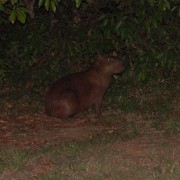Biodiversity
 Capybara
Hydrochoerus hydrochaeris | Linnaeus, 1766
Capybara
Hydrochoerus hydrochaeris | Linnaeus, 1766

Characteristics: The capybara is the world's largest rodent, measuring up to 130cm in length and standing 60cm tall. Its fur is dark-brown, and its paws have a swimming membrane.
Distribution: Colombia, Venezuela, Brazil, and Paraguay.
Habitat: Banks of rivers, lakes, river beaches, and marshlands.
Habits: This species is generally diurnal, but in the presence of man it may acquire nocturnal habits. It usually lives in family groups of two to thirty individuals, and there is always a dominant couple in the group.
Diet: Herbivorous, feeding on 3-4 kilograms of fresh vegetation per day.
Breeding: The gestation period ranges from 120 to 140 days, with more than one litter a year, and 2 to 6 offspring per litter.
In the UFRA area: The capybara was seen in seven of the ten environments studied. It was found in exotic woods, Wetlands with Herbaceous plants, Wetlands with Riparian Forests, Restored Native Forests, Drainage Ditches, Forests in Spontaneous Regeneration, and fields in spontaneous regeneration. Often found associated with wetlands, flooded environments, and bodies of water.





